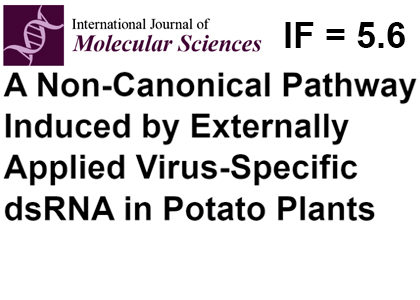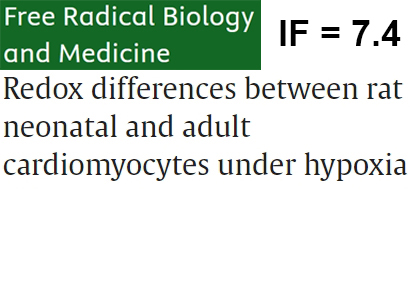Press-room / Digest

A non-canonical RNAi pathway induced by externally applied virus-specific dsRNA in plants
The external application of dsRNAh has recently been developed as a new approach for crop protection. It is assumed that the mechanism of dsRNA-mediated antivirus RNA defence is similar to that of natural RNA interference (RNAi). There is, however, no direct evidence to support this idea. Scientists from the IBCh RAS in collaboration with colleagues from JHI (UK) we carried out the analysis of small RNAs (sRNA) as hallmarks of RNAi induced by potato virus Y (PVY). In contrast to PVY-induced production of discrete 21 and 22 nt sRNA species, the externally administered PVY dsRNA led to generation of a non-canonical pool of sRNAs, which were present as ladders of ~18-30 nt in length; suggestive of an unexpected sRNA biogenesis. These findings may have significant implications for further developments in dsRNA-mediated crop protection. The results are published in the International Journal of Molecular Sciences. Learn more

Redox differences between neonatal and adult cardiomyocytes under hypoxia
A team of scientists from the IBCh RAS, Lomonosov Moscow State University and other Russian institutes studied the differences in the redox state of neonatal and adult rat cardiomyocytes under hypoxic conditions. Using the highly sensitive HyPer7 biosensor, authors found that hypoxia causes an increase in H2O2 production in adult cardiomyocytes, while neonatal cells, on the contrary, experience a decrease in basal H2O2 levels under the same conditions. This finding correlates with other data obtained by the authors using Raman microspectroscopy, which demonstrate a marked difference in the properties of the mitochondrial electron transport chain of adult and neonatal cells. In particular, in adult cardiomyocytes, hypoxia causes the significant increase in the respiratory chain loading with electrons, while in neonatal cells this effect is not observed. The work was published in Free Radical Biology and Medicine journal. Learn more

Aging Modulates the Ability of Quiescent Stem Cells in the Hippocampal Dentate Gyrus to be Recruited into Division by Pro‑neurogenic Stimuli
Transient or persistent perturbations of the balance between quiescence and division of the hippocampal stem cells due to a brain pathology or therapy can lead to unfavorable long-term outcomes such as premature depletion of their pool, decreased neuronal renewal, and cognitive deficit. Here, using a recently developed method for detection of de novo dividing cells, the members of the redox biology group and the laboratory of molecular technologies from the Department of Metabolism and Redox Biology, IBCH RAS, in the collaboration with colleagues from IHNA&NPh revealed that long-term stimulation of divisions of quiescent stem cells led to premature exhaustion of their pool and that aging of the brain modulates the ability of the quiescent stem cells to be recruited into the cell cycle by pro-neurogenic stimuli. Results of the study have a number of implications for the practical assessment of drugs and treatments with respect to their action on quiescent stem cells at different stages of life in animal preclinical studies. The work is published in the Molecular Neurobiology.

Venom-gland transcriptomics and venom proteomics of the Tibellus oblongus spider
Scientists from the Laboratory of Neuroreceptors and Neuroregulators of the Institute of Bioorganic Chemistry, Russian Academy of Sciences, in collaboration with colleagues from the Institute of Experimental Chemical Physics named after. V.L. Talroze Federal Research Center for Chemical Physics of the Russian Academy of Sciences, using a combined approach of transcriptomics and proteomics, conducted a comprehensive analysis of the polypeptide composition of the venom of the Central Asian spider Tibellus oblongus. Based on analysis of the EST (Expressed Sequence Tags) database, the amino acid sequences of 345 precursor proteins and 217 mature toxins were determined. Using bottom-up proteomics, 212 natural toxins were detected in the venom sample and the post-translational modifications were confirmed. This is the first time that the primary structure has been determined simultaneously for numerous toxins from one spider species. Analysis of the primary structure indicated that some molecules have an ICK (inhibitor cystine knot) organization common for spider toxins, but a significant part of the toxins represents new structural motifs and have no homology with known peptides. The study was published in the Scientific Data.

Hybrid protein-peptide system for the selective pH-dependent binding and photodynamic ablation of cancer cells
Photodynamic therapy (PDT) as a cancer treatment modality is currently attracting increasing attention. However, PDT is also characterized by undesirable effects of sunlight on healthy tissues. Employees of the IBCH RAS have obtained a hybrid protein-peptide construct for selective binding and subsequent photodynamic ablation of cancer cells. A peptide fragment was used as a targeting module, which pH-dependently binds to the cancer cell. A mutant of miniSOG protein covalently linked to the peptide was used as a photosensitising component. It was shown that such a protein-peptide construct selectively binds to HeLa cells at pH below 6.8 and destroys them upon exposure to light. The results demonstrate the possibility of using such complexes for targeted delivery to cancer cells and subsequent high-precision PDT. The work is published in the journal J. Photochem. Photobiol. B: Biol.

